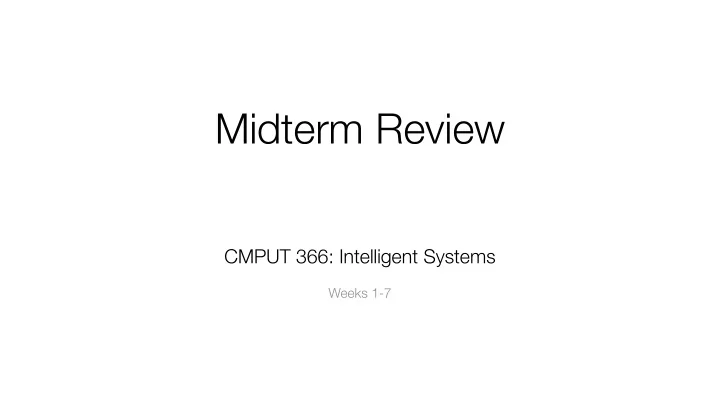

Midterm Review CMPUT 366: Intelligent Systems Weeks 1-7
Lecture Structure 1. Exam structure and details 2. Learning objectives walkthrough • Clarifying questions are the point of this class 3. Other questions, clarifications
Midterm Details • The midterm is Monday, March 11 at 3pm in CSC B-2 • Regular time and classroom • There will be 60 minutes available for the exam • You may bring a single, handwritten cheat sheet if you wish • Weeks 1 through 7 are included • Everything up to and including Convolutional Neural Nets
Midterm Structure • There will be 60 marks total • There will be 10 short answer questions with 1-2 sentence answers • The rest will be more in-depth • There will be no coding questions • But you may be asked to execute a few steps of an algorithm • Every question will be based on the learning objectives that we are about to walk through
Introduction to AI • characterize simplifying assumptions made in building AI systems • determine what simplifying assumptions particular AI systems are making • suggest what assumptions to lift to build a more intelligent system than an existing one • define the major representational dimensions • classify problem statements by representational dimensions
Search • define a directed graph • represent a problem as a state-space graph • explain how a generic searching algorithm works
Search (2) • demonstrate how depth-first search will work on a graph • demonstrate how breadth-first search will work on a graph • demonstrate how iterative deepening DFS will work • demonstrate how least cost first search will work on a graph • predict the space and time requirements for depth-first and breadth-first searches
Search (3) • devise a useful heuristic function for a problem • demonstrate how best-first and A* search will work on a graph • predict the space and time requirements for best-first and A* search • justify why and when depth-bounded search is useful • demonstrate how iterative-deepening works for a particular problem • demonstrate how depth-first branch-and-bound works for a particular problem
Search (4) • define hill climbing, random step, random restart • explain why hill climbining is not complete • explain why adding random restarts to hill climbing makes it complete • justify when local search is appropriate for a given problem
Search (5) • list the elements of a local search problem • recognize a local search problem • explain how the generic local search algorithm works • define hill climbing and stochastic local search • trace an execution of hill-climbing and stochastic local search • define improving step, random step, and random restart • explain the benefits of random steps and random restarts
Uncertainty • define a belief network • build a belief network for a domain • build a correct belief network for a given joint distribution • compute marginal and conditional probabilities from a joint distribution
Uncertainty (2) • define a random variable • describe the semantics of probability • apply the chain rules • apply Bayes' theorem
Uncertainty (3) • define the factor objects and factor operations used in variable elimination • explain the origins of the efficiency improvements of variable elimination • define the high-level steps of variable elimination • trace an execution of variable elimination
Uncertainty (4) • justify why a belief network is a correct encoding of a joint distribution • identify the factorization of a joint distribution encoded by a belief network • answer queries about independence based on a belief network • answer queries about independence based on a joint distribution
Causality • define observational and causal query • explain the difference • explain why causal queries on observational distributions can go wrong • construct the post-intervention distribution for a causal query from an observational distribution • evaluate a causal query given an observational distribution • justify whether a causal model is valid
Causality (2) • define a back-door path • identify a back-door path • define the back-door criterion • identify whether a causal query is identifiable from a partially- observable causal model
Supervised Learning • define supervised learning task, classification, regression, loss function • represent categorical target values in multiple ways (indicator variables, indexes) • identify an appropriate loss function for different tasks • explain why a separate test set estimates generalization performance • define 0/1 error, absolute error, (log-)likelihood loss, mean squared error, worst-case error
Supervised Learning (2) • define generalization performance • construct a decision tree using given features, splitting conditions, and stopping conditions • define overfitting • explain how to avoid overfitting
Supervised Learning (3) • explain how to use the Beta and Bernoulli distributions for Bayesian learning • derive the posterior probability of a model using Bayes' rule • define conjugate prior • demonstrate model averaging
Supervised Learning (4) • estimate expectations from a finite sample • apply Hoeffding's inequality to derive PAC bounds for given quantities • demonstrate the use of rejection sampling and importance sampling
Deep Learning • define an activation • define a rectified linear unit and give an expression for its value • describe how the units in a feedforward network are connected • give an expression in matrix notation for a layer of a feedforward network • explain at a high level what the Universal Approximation Theorem means • explain at a high level how feedforward neural networks are trained • identify the parameters of a feedforward neural network
Deep Learning (2) • define sparse interactions and parameter sharing • define the convolution operation • define the pooling operation • explain why convolutional networks are more efficient to train • describe how the units/layers in a convolutional neural network are connected
Questions?
Recommend
More recommend